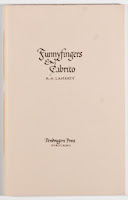I'm currently rereading both Fourth Mansions and Arrive at Easterwine. While they are arguably tighter novels than The Devil is Dead and Archipelago, it strikes me that they have in common a narrative that is interrupted at times by reflection and reverie.
Nowhere is this more apparent than in the longish excerpt from Archipelago that Daniel posted on his blog. In this example, the narrative starts in Hans' drunken reverie and switches to the real world seamlessly, without losing any of the feeling of idle daydream. He starts thinking about Marie's eyes and imagining the stories she would tell in her half of the conversation, and then she arrives and the conversation continues with Marie actually participating. However, at no point does the the conversation lose that kind of loose, tangential feeling of a drunken reverie.
The experience of reading The Devil is Dead has always struck me as awakening from just such a reverie. The individual scenes are striking, but it is very hard to remember how the book fits together. It has a very dream-like narrative, especially when you consider the prescience Finnegan has about the two lives and two faces of Papadiabolous. And of course, the book is peppered with drunken stories told by the characters.
The narrative in Arrive at Easterwine exists on many levels of metaphor, and several times dispenses completely with straightforward narration of the supposed real world. I think the most pronounced example is the recurrent meditation on the Balbo family crest and its thrice-painted center emblem, El Brusco (the sudden or brusk one), La Brusca (the burning bush or passion or love), and Labrusca (the spring wine or Easter wine). Again, this narrative is in the form of a thought running into a tangential thought running into a deep analysis of an imagined detail. It is a recurrent daydream through the narrative that deeply informs and prefigures the story at each turn.
Even Fourth Mansions which is a pretty tightly written action narrative (for Lafferty) takes time to digress into the qualities of the different animals, the reasons for various impressions, and hallucinatory sequences that have more in common with dream logic than waking logic. For sheer reverie there was the rambling examination of Freddy's memories about the poor neighborhood of Tulsa and why he was afraid when he was there. Elements of that kept cropping up later on in the story, like the references to Leo Joe Larker having raised a boy from the dead when he was no more than ten years old. For sheer hallucinatory interludes there were the scene where Freddy was trying to reach Biddy via brain weave, and she was distracted on subterranean beaches while wild dogs tore her apart, and the multiple metaphorical scenes of the final battle between Arouet Manion and James Bauer.
A reviewer once said "One awakens from reading a Lafferty book as from a dream." I think that is particularly apt. His novels make more sense when you allow them to follow their own logic, and read along almost in a dream-like state or drunken reverie of your own in parallel. The result is that the individual images and impressions are striking and powerfully remembered, but the plot works directly on the subconscious, leaving very little conscious trace.


















































